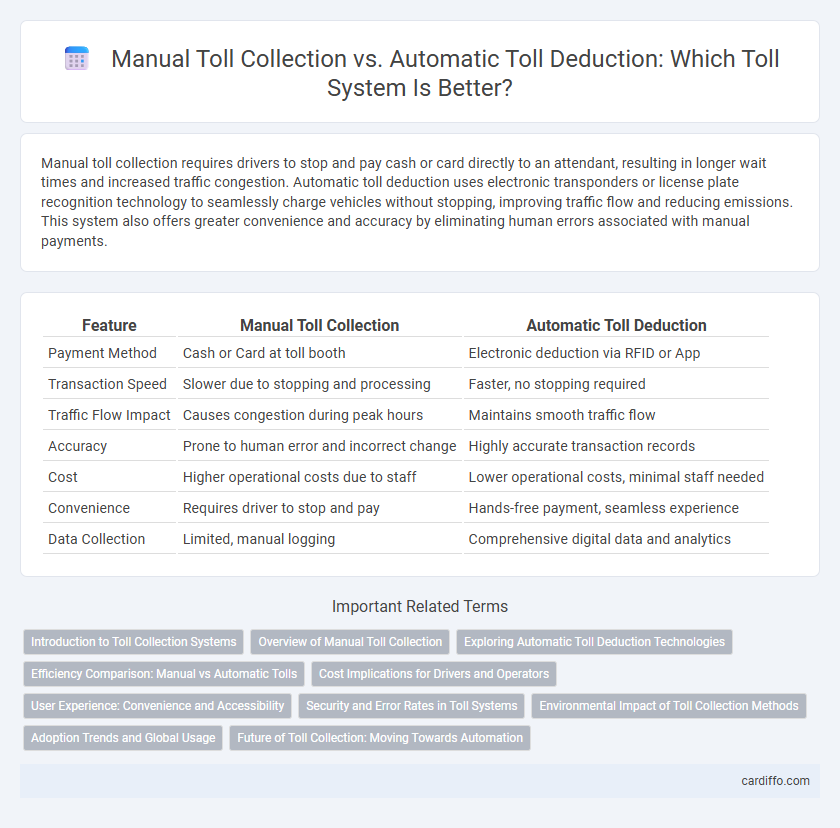Manual toll collection requires drivers to stop and pay cash or card directly to an attendant, resulting in longer wait times and increased traffic congestion. Automatic toll deduction uses electronic transponders or license plate recognition technology to seamlessly charge vehicles without stopping, improving traffic flow and reducing emissions. This system also offers greater convenience and accuracy by eliminating human errors associated with manual payments.
Table of Comparison
| Feature | Manual Toll Collection | Automatic Toll Deduction |
|---|---|---|
| Payment Method | Cash or Card at toll booth | Electronic deduction via RFID or App |
| Transaction Speed | Slower due to stopping and processing | Faster, no stopping required |
| Traffic Flow Impact | Causes congestion during peak hours | Maintains smooth traffic flow |
| Accuracy | Prone to human error and incorrect change | Highly accurate transaction records |
| Cost | Higher operational costs due to staff | Lower operational costs, minimal staff needed |
| Convenience | Requires driver to stop and pay | Hands-free payment, seamless experience |
| Data Collection | Limited, manual logging | Comprehensive digital data and analytics |
Introduction to Toll Collection Systems
Manual toll collection requires drivers to stop at booths and pay tolls using cash or card, which can cause traffic congestion and delays. Automatic toll deduction systems use RFID tags or license plate recognition technology to charge vehicles electronically, enabling seamless traffic flow and reducing operational costs. These advanced systems improve efficiency by minimizing human intervention and enhancing real-time toll management capabilities.
Overview of Manual Toll Collection
Manual toll collection involves toll booth operators physically collecting payments from drivers, often using cash or cards. This method can result in longer wait times due to vehicle queues and slower transaction speeds compared to automated systems. Despite being labor-intensive, manual toll collection remains prevalent in regions lacking advanced electronic toll infrastructure.
Exploring Automatic Toll Deduction Technologies
Automatic toll deduction technologies utilize RFID tags, license plate recognition cameras, and electronic transponders to streamline toll payments and reduce congestion at toll plazas. These systems enable real-time account debiting without requiring vehicles to stop, enhancing traffic flow and minimizing human errors associated with manual toll collection. Integration with mobile apps and cloud-based platforms further improves user convenience and facilitates seamless toll management across multiple regions.
Efficiency Comparison: Manual vs Automatic Tolls
Automatic toll deduction significantly enhances efficiency by reducing vehicle wait times and minimizing congestion at toll plazas. Manual toll collection requires physical currency handling and human intervention, leading to slower processing and increased operational costs. Electronic toll systems improve traffic flow and provide accurate, real-time transaction data for better toll management and maintenance planning.
Cost Implications for Drivers and Operators
Manual toll collection incurs higher operational costs due to labor expenses and slower traffic flow, leading to increased fuel consumption and driver time loss. Automatic toll deduction systems reduce expenses by minimizing staffing needs and enabling faster throughput, resulting in lower vehicle emissions and improved fuel efficiency. For drivers, electronic tolling offers cost savings through time efficiency, while operators benefit from streamlined revenue collection and reduced maintenance overhead.
User Experience: Convenience and Accessibility
Manual toll collection requires drivers to stop and pay cash or show a card, causing delays and inconvenience, especially during peak hours. Automatic toll deduction systems use electronic transponders or license plate recognition, enabling seamless, contactless passage that significantly improves convenience and accessibility. This technology reduces wait times, supports multiple payment methods, and enhances the overall user experience on toll roads.
Security and Error Rates in Toll Systems
Manual toll collection often involves human error and poses higher security risks due to cash handling and potential theft, leading to increased error rates in transaction recording. Automatic toll deduction systems enhance security by using encrypted RFID or license plate recognition technologies, significantly reducing errors and preventing fraudulent activities. Advanced automatic systems also enable real-time monitoring and auditing, improving accuracy and minimizing revenue loss.
Environmental Impact of Toll Collection Methods
Manual toll collection generates higher vehicle emissions due to frequent idling and stop-and-go traffic at toll plazas, contributing to increased air pollution and greenhouse gas emissions. Automatic toll deduction systems, such as electronic toll collection (ETC), reduce congestion by enabling seamless toll payments, lowering fuel consumption and carbon footprint. Implementing widespread ETC adoption supports sustainable transportation and reduces the overall environmental impact of toll operations.
Adoption Trends and Global Usage
Manual toll collection is increasingly being replaced by automatic toll deduction systems due to their efficiency and reduced traffic congestion. Countries like the United States, India, and China have seen rapid adoption of electronic toll collection (ETC) technologies such as RFID and license plate recognition, leading to smoother traffic flow and lower operational costs. Global usage trends indicate a growing preference for automated toll systems, driven by advancements in IoT and digital payment infrastructure.
Future of Toll Collection: Moving Towards Automation
The future of toll collection is rapidly shifting towards automation with automatic toll deduction systems like RFID and ANPR becoming standard, reducing traffic congestion and enhancing efficiency. Manual toll collection, reliant on human operators, is increasingly viewed as inefficient and prone to errors, leading to higher operational costs and longer wait times. Advanced technologies, such as contactless payment and real-time toll processing, are driving widespread adoption of automated tolling infrastructure worldwide.
Manual toll collection vs Automatic toll deduction Infographic

 cardiffo.com
cardiffo.com